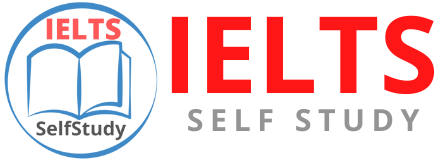There are 5 main types of IELTS Task 2 essays:
Most questions fit one of these categories. However, questions can be written in many different ways, which can make it difficult to determine which type they are.
On this page, I want to give you an overview of all 5 IELTS Task 2 essay types, with samples questions to help you recognise some of the different wording often used. I’ve also included a basic structure for each that you can use to as a guide for essay planning, a vital step in the writing process.
I go into each type of question in more detail on its own page. Click the links above or at the bottom of this page to see these.
First, here’s the basic 4 part structure I recommend that you use for Task 2 essays:
1) Introduction
2) Main Body Paragraph 1
3) Main Body Paragraph 2
4) Conclusion
The sort of information you include in each of the 4 sections will vary depending on the question type and that’s what I’m now going to outline for you.
These easy to learn structures will enable you to quickly plan and write any IELTS Task 2 essay.
The structures below are not the only ones you could use but they are the ones I recommend because they’re simple and give proven results.
1) Opinion Essays
These are sometimes called ‘agree or disagree’ or ‘argumentative’ essays and are one of the most common types of IELTS Task 2 question.
The first part of the question will be a statement. You will then be asked to give your own opinion about the statement. Here is some typical wording that might be used:
- What is your opinion?
- Do you agree or disagree?
- To what extent do you agree or disagree?
Here is an example of each:
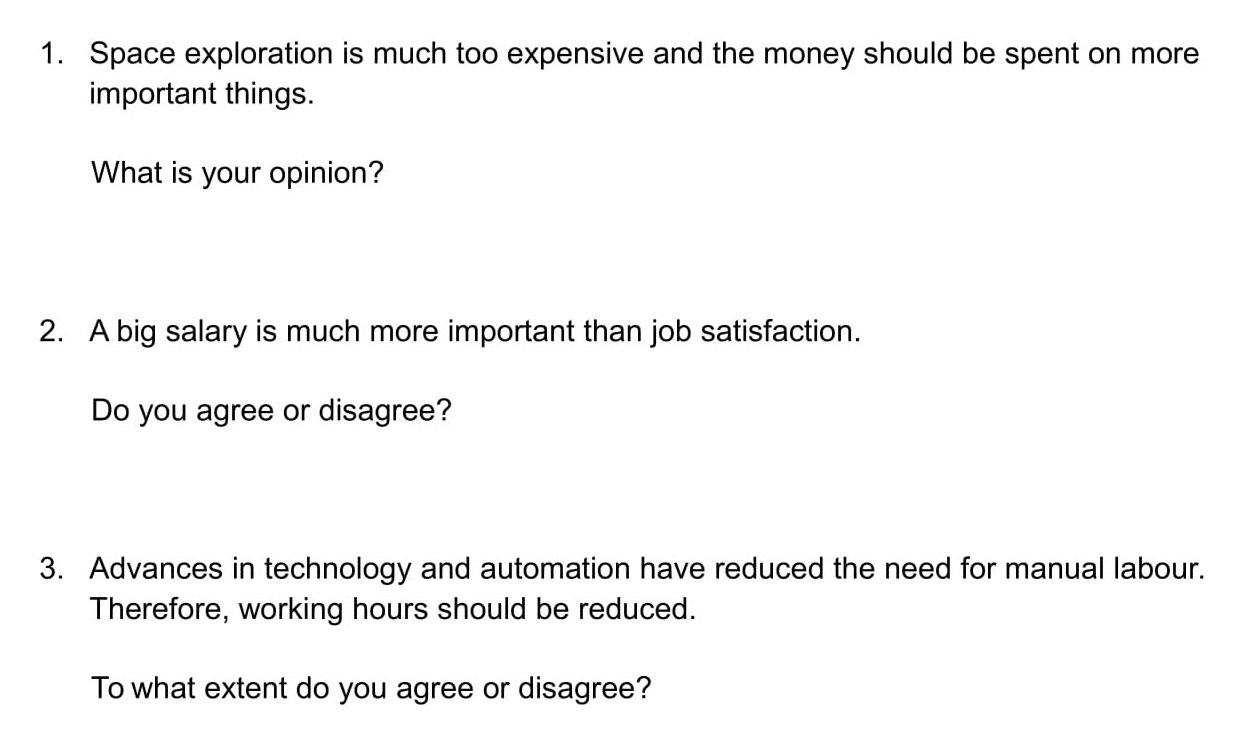
Key tips:
-
- Choose one side of the argument.
- State your opinion clearly in the introduction.
- Keep the same opinion throughout the essay.
- Give reasons why you hold this view.
It doesn’t matter which side of the argument you take or even that you agree with it. Choose the one you can develop the best argument for.
Don’t change your opinion part way through the essay and don’t give reasons for the opposing idea.
Essay Structure
1) Introduction
- Paraphrase the question
- Give your opinion
- State two supporting reasons
2) Main body paragraph 1
- Topic sentence – outline 1st reason for supporting this view
- Explanation – explain this idea
- Example – give an example
3) Main body paragraph 2
- Topic sentence – outline 2nd reason for supporting this view
- Explanation – explain this idea
- Example – give an example
4) Conclusion
- Summarise opinion and key reasons
2) Discussion Essays
In discussion essays, you have to discuss both sides of an argument. Usually, you will be asked for your own opinion as well.
The easiest way to approach this type of IELTS Task 2 question is to choose one point of view to agree with and one side to disagree with.
Here are 3 examples of discussion essay questions:
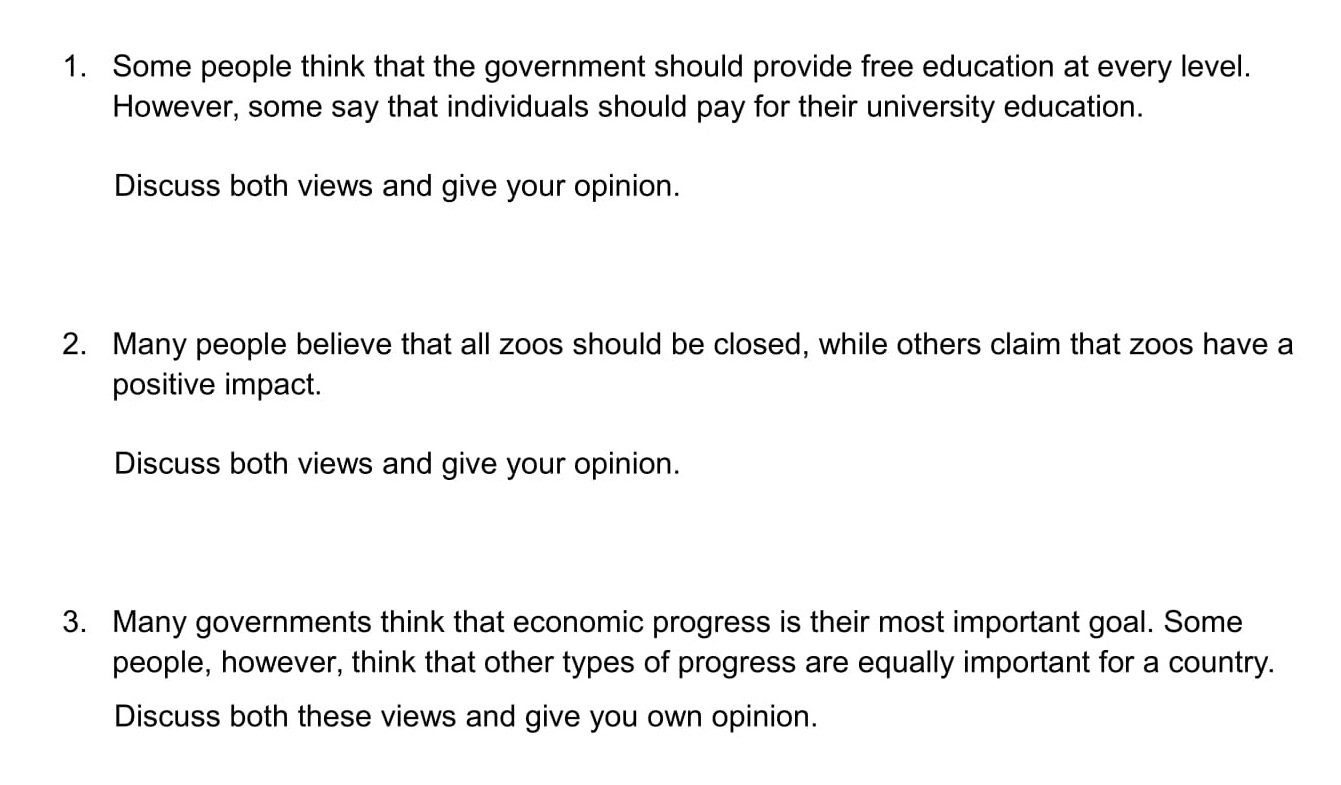
Key tips:
-
- Develop both sides of the argument.
- Talk about the view you don’t agree with first.
A big mistake many students make is to fully develop only one point of view. This leads to an unbalanced essay and a low score for task achievement.
It is easier to begin by discussing the opinion you don’t agree with and then present the reasons for your opposing view.
Essay Structure
1) Introduction
- Paraphrase the question
- Give your opinion
- State two supporting reasons
2) Main body paragraph 1 – Negative Viewpoint
- Topic sentence – outline the view you don’t agree with
- Explanation – explain why this view is held by some people
- Example – give an example
3) Main body paragraph 2 – Positive Viewpoint
- Topic sentence – outline the view you do agree with
- Explanation – explain why this view is held by some people
- Example – give an example
4) Conclusion
- Summarise the key points and state your opinion
These are sometimes called ‘causes and solutions’ or ‘problems and solutions’ essays. This type of IELTS Task 2 question starts with a statement, then asks you to discuss the problems or causes and the solutions.
Key tips:
-
- Don’t list lots of causes and solutions.
- Choose just one or two and develop them fully.
- Be sure to link each problem/cause and its solution.
A common mistake is for candidates to list all the problems/causes and solutions they can think of, not necessarily linking them together. They also fail to explain any of them in detail and don’t include any examples.
The wording of this type of essay question can vary considerably. Here are 3 examples of problem essay questions:
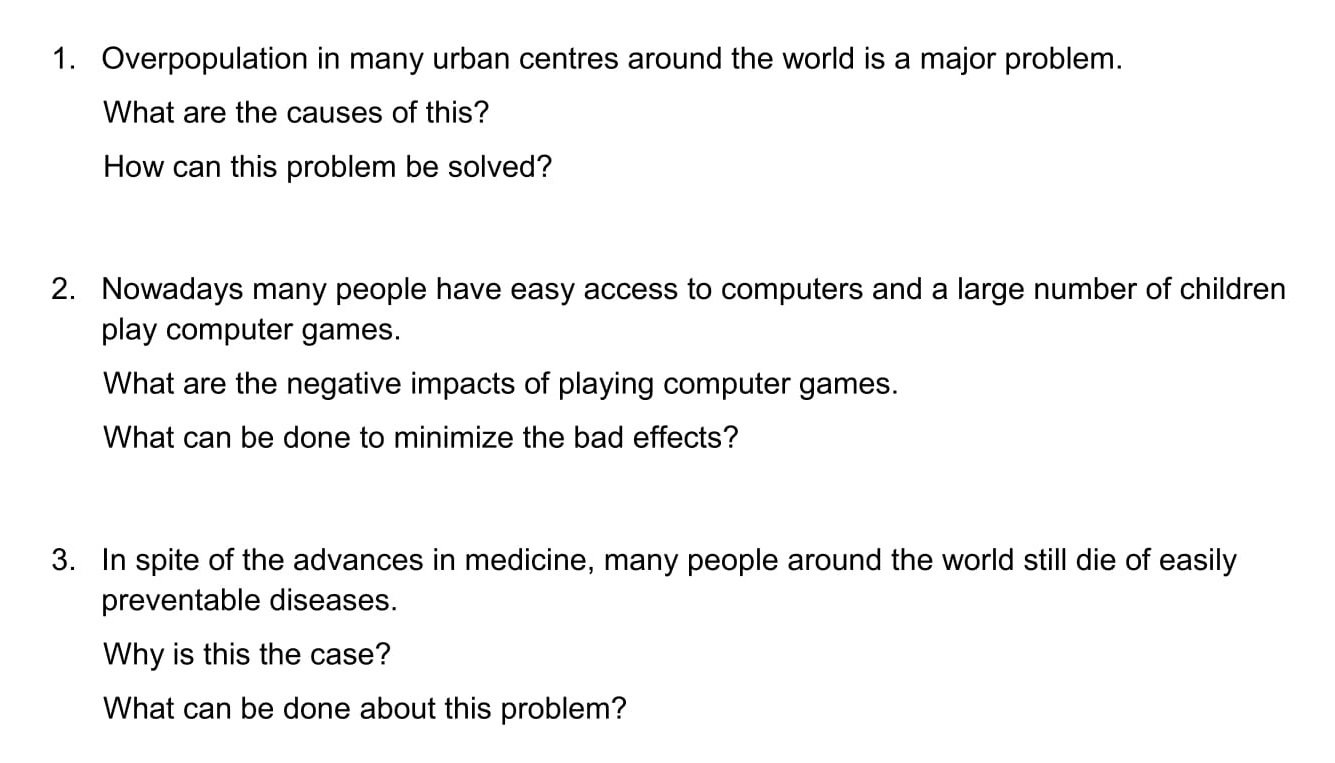
Essay Structure
1) Introduction
- Paraphrase the question
- State 1 key problem/cause and related solution
2) Main body paragraph 1 – Problem or Cause
- Topic sentence – state the problem or cause
- Explanation – give detail explaining the problem or cause
- Example – give an example
3) Main body paragraph 2 – Solution
- Topic sentence – state the solution
- Explanation – give detail explaining the solution
- Example – give an example
4) Conclusion
- Summarise the key points and state your opinion
4) Advantages & Disadvantages Essays
The first part of the question will be a statement. You will be asked to write about both the advantages and disadvantages of the idea stated.
Here is some typical wording that might be used:
-
- What are the advantages and disadvantages of….?
-
- Do you think the advantages outweigh the disadvantages?
-
- Discuss the advantages and disadvantages and give your opinion.
Here are 3 examples of advantages and disadvantages essay questions:
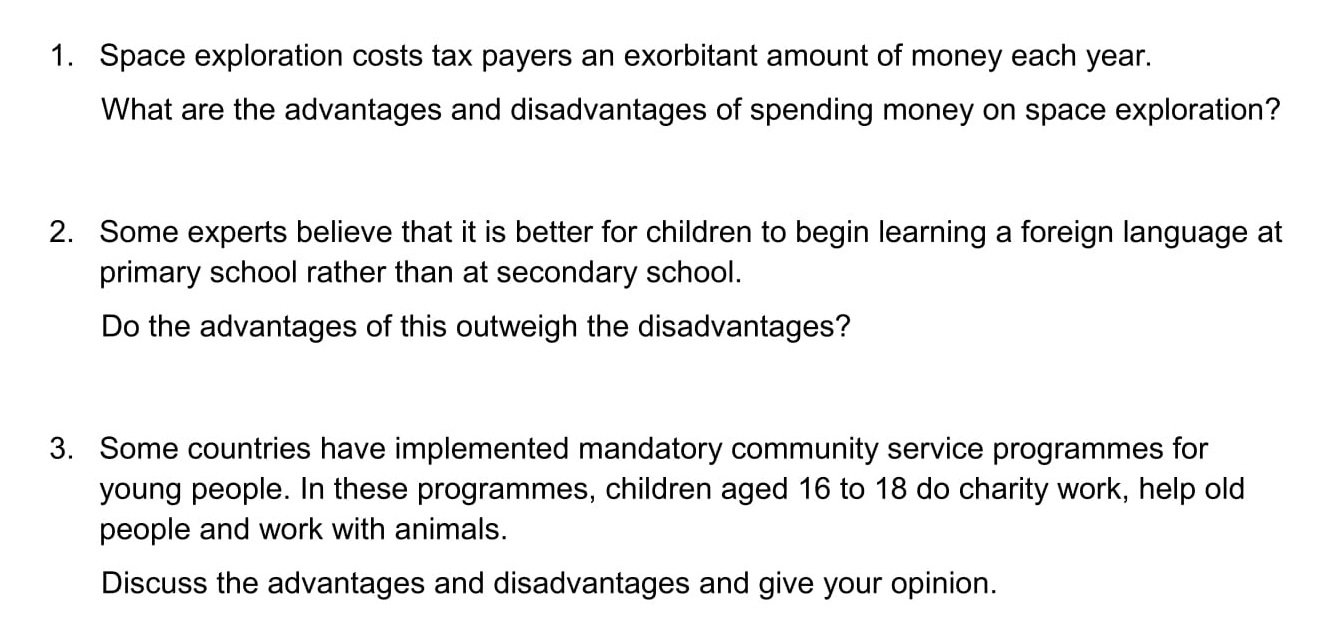
Each of these different types of questions fits into one of two slightly different essay structures. We’ll look at these in detail on the main IELTS Task 2 Advantages & Disadvantages Essays page. For now, I’ll give you the basic structure.
Essay Structure
1) Introduction
- Paraphrase the question
- Outline the view or views stated the statement
2) Main body paragraph 1 – Advantage
- Topic sentence – state 1 advantage
- Explanation – give detail explaining the advantage
- Example – give an example
- Result – state the result
3) Main body paragraph 2 – Disadvantage
- Topic sentence – state 1 disadvantage
- Explanation – give detail explaining the disadvantage
- Example – give an example
- Result – state the result
4) Conclusion
- Summarise the key points
- State your opinion if required
5) Double Question Essays
This type of IELTS Task 2 question is sometimes called a ‘direct question’ or ‘two questions’ essay. It has one statement with two different questions after it. The questions may or may not be linked.
Key tips:
-
- You must answer both questions fully.
-
- Don’t confuse it with an opinion or a discussion essay.
-
- Be careful that you don’t end up with too many ideas to write about.
Here are 3 examples of double question essay questions:
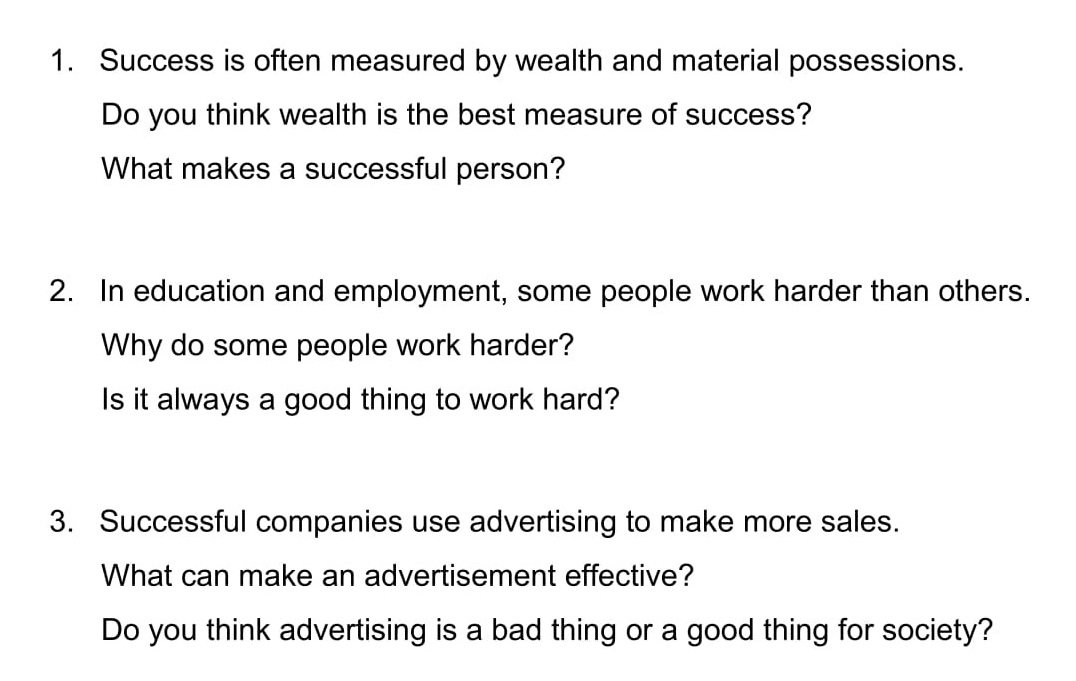
Essay Structure
1) Introduction
- Paraphrase the question
- Outline sentence – state your answer to both questions
2) Main body paragraph 1 – Answer question 1
- Topic sentence – state your answer
- Explanation – explain why you think this
- Example – give an example
3) Main body paragraph 2 – Answer question 2
- Topic sentence – state your answer
- Explanation – explain why you think this
- Example – give an example
4) Conclusion
- Summarise both questions and answers
I hope you’ve found this information useful. You can learn lots more about writing the 5 different types of IELTS Task 2 essay and see sample answers on these pages:
The 5 Task 2 Essay Types:
Step-by-step instructions on how to plan & write high-level essays. Model answers & common mistakes to avoid.
